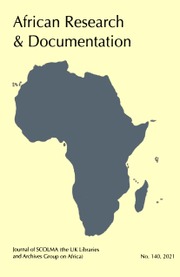No CrossRef data available.
Article contents
Bibliographies of Language Use in Sub-Saharan Africa: A Review Article
Published online by Cambridge University Press: 25 April 2022
Abstract

Information
- Type
- Book Reviews and Notes
- Information
- Copyright
- Copyright © International African Institute 1983
References
Notes
1. Mechthild, R.E.H. Problems of linguistic communication in Africa. African Linguistic Bibliographies 1, edited by Rottland, Franz and Vosen, Rainer Hamburg, Helmut Buske, 1981. 230Google Scholar p, 2 maps. DM 42. ISBN 3 87118 509 4.
2. Heine, Bernd. Sprache, Gesellschaft und Kommunikation in Africa. (Language, society and communication in Africa). Afrika Studien 103. Munchen, Weltforum, 1979.Google Scholar
3. Doualamou, Germain. Langues guinéennes et éducation. Paris, Unesco, Division des structures, contenus methodes et techniques de l'education, 1980.Google Scholar
4. Access to Unesco's plethoric production of documents and publications is best had through its computerised current lists. Documents are available both on paper and on microfiche.
5. Ngara, E.A. Bilingualism, language contact and planning — proposals for language use and language teaching in Zimbabwe. Gwelo, Mambo Press, 1982. xii, 162 p.Google Scholar This is a revised version of the author's Ph D thesis, London University, 1977.
6. I use the term metalect or link language (also received language) in preference to exolect (imported, imposed) or foreign language, as better describing the actual function and status of these languages — Arabic, English, French, Portuguese.
7. An excellent recent comparative study of language policies in Africa is Denis Turcotte: La politique linguistique en Afrique francophone — une étude comparative de la Cote d'lvoire et de Madagascar. Quebec, Presse de l'Université Laval, 1981. 219 p. It is not yet listed in the bibliography under review.
8. Abdulaziz, Mohammed H. The ecology of Tanzanian national language policy. In: Polome, Edgar C. and Hill, Peter C. (editors). Language in Tanzania. London, International African Institute and OUP, 1979. p 139–175.Google Scholar
9. According to the Chiang Mai conference, the United Bible Society decided to concentrate translations of the Bible into common (modern/colloquial) language of languages with above 1 million literates/speakers. This was somewhat extended at the recent regional African conference in Nairobi, December 1982, to include languages with official or ‘national’ status.
a. Brann, C.M.B. Language in education and society in Nigeria: a comparative bibliography and research guide. Quebec, International Centre for Research on Bilingualism, 1975, 233 p.
b. ibid. Language in society in West Africa - select bibliography. In West African journal of modern languages (Ibadan-Maiduguri), 3 (1978), p 194- 219.
c. ibid Language planning in education: trilingualism in Africa: select bibliography. In Trilingualism in language planning for education in sub-Saharan Africa. Paris, Unesco, 1981. (ED-81/WS/116).
d. ibid The future of European languages in Africa: select bibliography. Maiduguri, University of Maiduguri, Department of Languages and Linguistics, 1980. This bibliography was prepared for European languages in sub-Saharan Africa: perspective and prospective Brussels, European Cooperation Fund, 1980, but, being too long, was not included. It is to be published by the International Centre for Research on Bilingualism, Quebec.
e. Hachten, W.A. Mass communication in Africa: an annotated bibliography. Madison, University of Wisconsin, Center for International Communication Studies, 1971.
f. Hawkinson, Annie K. The survey of language use and language teaching in Eastern Africa a bibliography. Appendix B of M.H. Abdulaziz and M.J. Fox: Evaluation report on survey of language use and language teaching of Eastern Africa. New York/Nairobi, Ford Foundation, 1978, 35 p. This bibliography contains some 500 references, many of which are relevant to linguistic communication in Africa, but do not seem to have been available to the compiler in Cologne.
g. Molnos, Angela. Language problems in Africa a bibliography (1946-1967) and summary of the present situation, with special reference to Kenya, Tanzania and Uganda. Nairobi, East African Research Information Centre, 1969, 62 p. (EARIC Information Circular no. 2).

